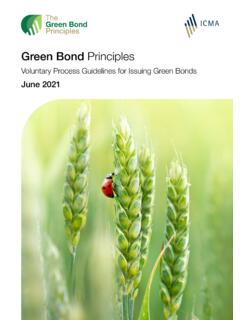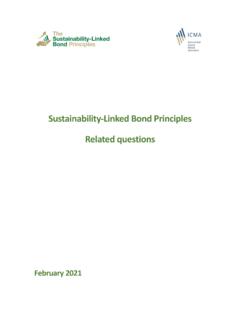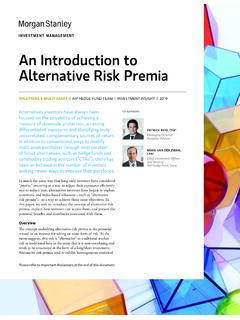Transcription of Frequently Asked Questions on Repo
1 Page 1 of 60 2019 International Capital Market Association (ICMA) Frequently Asked Questions on Repo Published by the International Capital Market Association (ICMA) in February 2013 and amended in January 2019. These FAQs are provided for information purposes only and should not be relied upon as legal, financial or other professional advice. While the information contained herein is taken from sources believed to be reliable, ICMA does not represent or warrant that it is accurate or complete and neither ICMA nor its employees shall have any liability arising from or relating to the use of this publication or its contents, including any information on any third party website which may be referred to in this document. Understanding repo and the repo market .. 3 1. What is a repo? .. 3 2. What does repo do?.
2 4 3. What is the role of repo in the financial markets? .. 5 4. How big is the repo market? .. 9 5. Who are the main users of the repo market? .. 10 6. What types of asset are used as collateral in the repo market? .. 10 7. What are the typical maturities of repos? .. 12 8. What is general collateral (GC)? .. 12 9. What is a special in the repo market? .. 13 10. What is rehypothecation of collateral? .. 14 11. What is the difference between a repurchase transaction and a buy/sell-back? .. 15 12. What is an open repo?.. 16 13. What is the difference between repo and securities lending? .. 16 14. Is repo in Europe the same as repo in the US? .. 17 How repos are managed .. 18 15. Is repo riskless? .. 18 16. Does repo encourage lending to risky counterparties? .. 19 17. Who regulates the repo market? .. 19 18. Why is it important to document repo? .. 19 19. What is the GMRA? .. 21 Page 2 of 60 2019 International Capital Market Association (ICMA) 20.
3 How do repo parties ensure they have enough collateral? .. 22 21. What is a haircut? .. 22 22. Who is entitled to receive coupons, dividends or other income payments on a security being used as collateral in a repo? .. 23 23. Who can exercise the voting rights and corporate actions attached to equity and corporate bonds being used as collateral in a repo? .. 23 24. What is tri-party repo? .. 24 25. What happens if a party fails to deliver collateral in a repo?.. 26 26. What happens to repo in a default? .. 27 27. What does a repo CCP do? .. 29 28. What happens to repo transactions when interest rates go negative? .. 31 Topical issues .. 35 29. What has been the regulatory response in the repo market to the Great Financial Crisis? .. 35 30. What is short selling and what is the role of repo? .. 40 31. Do repos allow for infinite leverage? .. 41 32. Do changes in haircuts/margins exacerbate pro-cyclicality?
4 42 33. Do banks that lend through repo receive preferential treatment over other creditors? .. 43 34. Does repo encumber a borrower s assets? .. 43 35. Was a run on repo the cause of the Great Financial Crisis in 2007? .. 44 36. Is repo a type of shadow banking ? .. 46 37. Is repo used to remove assets from the balance sheet? .. 46 38. Could a repo rate benchmark replace LIBOR or EURIBOR? .. 47 39. How do MiFID II and MiFIR apply to the repo market in the EU? .. 49 Special articles .. 51 40. Mapping the interdealer European repo market (January 2019) .. 51 International Capital Market Association (ICMA) and European Repo and Collateral Council (ERCC) .. 60 These FAQs have been written by Richard Comotto, Senior Visiting Fellow at the ICMA Centre at Reading University. Page 3 of 60 2019 International Capital Market Association (ICMA) Understanding repo and the repo market 1.
5 What is a repo? Repo is a generic name for both repurchase transactions and In a repo, one party sells an asset (usually fixed-income securities) to another party at one price and commits to repurchase the same or another part of the same asset from the second party at a different price at a future date or (in the case of an open repo) on If the seller defaults during the life of the repo, the buyer (as the new owner) can sell the asset to a third party to offset his loss. The asset therefore acts as collateral and mitigates the credit risk that the buyer has on the seller. Although an asset is sold outright at the start of a repo, the commitment of the seller to buy back the asset in the future means that the buyer has only temporary use of that asset, while the seller has only temporary use of the cash proceeds of the initial sale. Thus, although repo is structured legally as a sale and repurchase of securities, it behaves economically like a collateralised or secured deposit (and the principal use of repo is in fact the secured borrowing and lending of cash).
6 The difference between the price paid by the buyer at the start of a repo and the price he receives at the end is his return on the cash that he is effectively lending to the seller. In repurchase transactions, and now usually in the case of buy/sell-backs, this return is quoted as a percentage per annum rate and is called the repo rate. Although not legally correct, the return itself is usually referred to as repo interest. An example of a repo is illustrated below. 1 Repos are sometimes known as sale-and-repurchase agreements or just repurchase agreements . In some markets, the name repo can be taken to imply repurchase transactions only and not buy/sell-backs. Repurchase transactions are also known as classic repo . Under EU regulation --- along with securities lending, commodities lending and margin lending --- repurchase transactions and buy/sell-backs are types of securities financing transaction (SFT).
7 2 In the Global Master Repurchase Agreement (GMRA), the same or similar assets are described as Equivalent Securities . Equivalent means assets that are economically but not necessarily legally identical (the same issue of securities with the same ISIN or, if the issue is divided into classes or tranches, the same class or tranche, but not the same part of that issue, class or tranche). Page 4 of 60 2019 International Capital Market Association (ICMA) The buyer in a repo is often described as doing a reverse repo (ie buying, then selling). A repo not only mitigates the buyer s credit risk. Provided the asset being used as collateral is liquid, the buyer should be able to refinance himself at any time during the life of a repo by selling or repoing the assets to a third party (he would, of course, subsequently have to buy the same or a similar asset back in order to return it to his repo counterparty at the end of the repo).
8 This right of use (often called re-use) mitigates the liquidity risk that the buyer takes by lending to the seller. Because lending through a repo exposes the buyer to lower credit and liquidity risks, repo rates should be lower than unsecured money market rates. There is a definition of repo in the EU s Securities Financing Transactions Regulation (SFTR) but this is incorrect and should not be used other than for the purpose of reporting under the SFTR. Article 5 of the SFTR defines a repurchase transaction as a transfer of securities or commodities or guaranteed rights relating to title to securities or commodities where that guarantee is issued by a recognised exchange which holds the rights to the securities or commodities and the agreement does not allow a counterparty to transfer or pledge a particular security or commodity to more than one counterparty at one time . In reality, there are no repos against guaranteed rights and true repos do not use pledges.
9 In addition, SFTR incorrectly defines a buy/sell-back (see question 11). 2. What does repo do? Repo performs four basic functions which are fundamental to the efficient working of many other financial markets (see question 3). 1 One party can invest cash secured against the asset provided as collateral --- safe investment. 2 The counterparty can borrow cash in order to finance a long position in an asset, in an amount and at a repo rate that reflect, among other things, the collateral provided to the lender --- cheap 3 One party can earn a return by lending out an asset that is in demand in the market, in exchange for cheap cash, which can be used for funding or reinvested for profit (see question 9) --- yield enhancement for securities investors. 4 The counterparty can borrow an asset in order to sell and establish a short position or to deliver in order to settle a sale that has already been agreed (see question 30) --- short-selling and For lenders of cash (repo buyers), repo offers a safe investment because: The buyer receives collateral to hedge his credit risk on the seller.
10 Moreover, in a repo, title to the collateral is sold to the buyer, which should mean that, unlike pledged collateral, it can be liquidated in the event of the seller s insolvency without interference from an insolvency court. In other words, repo provides bankruptcy-remote collateral, which reduces the credit risk of a cash investor more than a traditional secured loan. The buyer can diversify his credit exposure by taking collateral issued by a third party whose credit risk is uncorrelated with the credit risk of the seller. Collateralisation through transfer of title can reduce, not only the credit risk arising from lending, but also the liquidity risk. Where a buyer is given liquid collateral, he can meet any unforeseen 3 A long position in an asset is created by buying the asset outright. The holder benefits from price rises, the accrual or payment of income on the asset and any other benefits of ownership.












